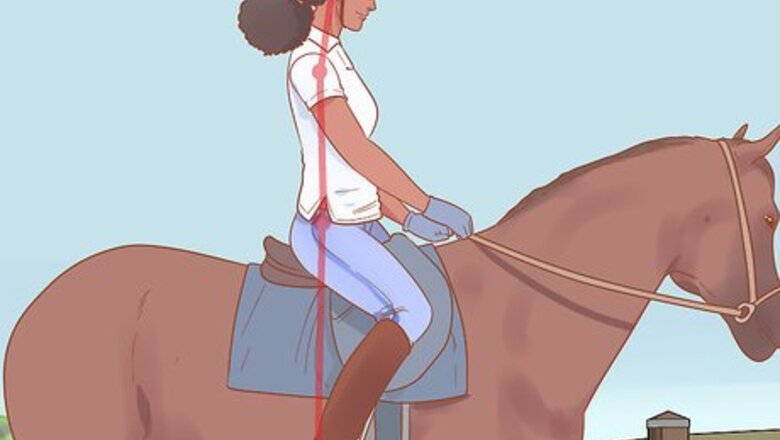
views
Maintaining the Correct Position

Create a straight line through your ear, shoulder, hip, and heel. Mount your horse and relax into the saddle. Imagine a line running from your ear down to your heel on both sides. Try to keep this alignment secure as you ride, as this keeps your weight over your horse’s center of gravity. To initially find this alignment, stand up in the stirrups and find the position where you can easily balance. Then gently lower yourself down onto your horse’s back. Your ear, shoulder, hip, and heel should be relatively in line and you may need to make only a few small adjustments. Losing this alignment can send your horse confusing signals as you are riding. If your legs slide forward, your weight will fall onto your horse’s back which is difficult for it to carry. Contrastingly, if your legs are too far back, you will tip forward.
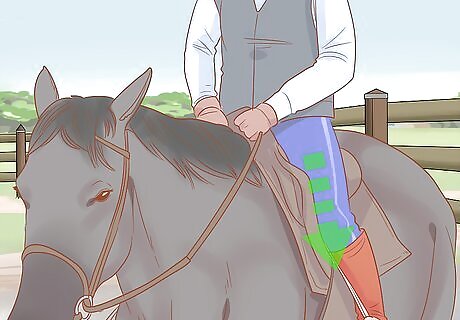
Hold your lower legs gently against your horse’s sides. Let your lower legs hang down from your knees. Wrap your lower legs softly around the sides of your horse. This causes your knees to open slightly and prevents you from gripping the saddle at the knee, which can cause you to be unbalanced.
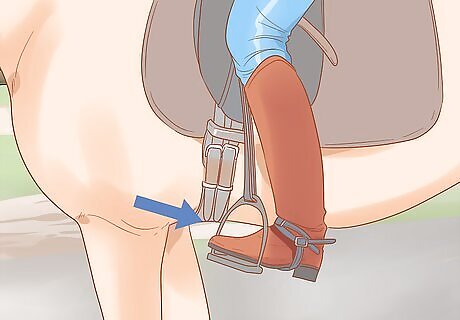
Adjust your feet so that the stirrups are along the ball of each foot. Gently push your heel below your toe and let your toes slightly point outward. Carry your weight evenly in each foot.
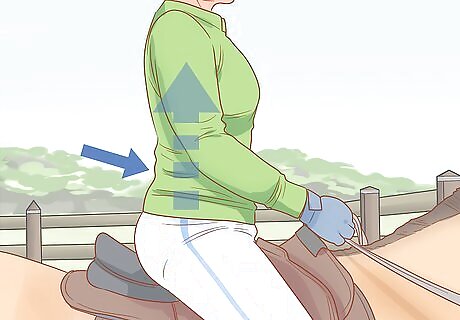
Relax your back to keep it straight. A relaxed, yet straight back is one of the most important aspects of having a correct riding posture. Avoid concentrating too much on having a straight back, as this often causes overcompensation which can make your back arch uncomfortably. If you feel nervous or tense during your ride, it’s common to perch in the saddle and for your back to arch without even realizing it. This tells your horse to tense up and to prepare for flight, which in turn makes both you and your horse tenser. Try to relax as much as possible, so that your position remains correct and your back stays straight. This will help you and your horse to communicate.
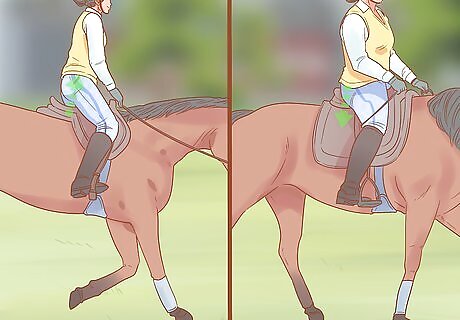
Follow your horse’s motion with your body. Move with your horse during your ride. Relax your body and feel how it moves as your horse moves. You will feel lifts and rolls through your hands, hips, seat, and legs. Feeling flexible and comfortable with your horse’s natural movement means that you will be able to understand how to use your seat and legs well to communicate with your horse.
Asking Your Horse to Walk and Turn
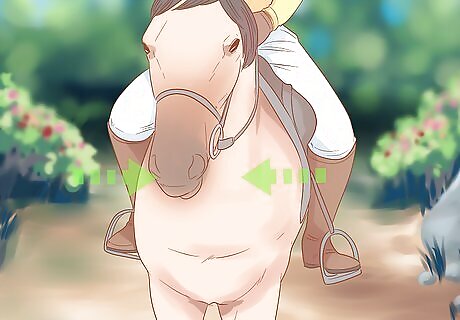
Squeeze your legs gently inwards to ask your horse to walk on. Position your weight evenly over the saddle and look straight ahead at where you want your horse to move towards. Gently pulse with your lower legs as your horse moves forward to maintain the motion. It can be helpful to lighten your seat as you ask your horse to walk on. Imagine that you are growing slightly taller towards the sky, rather than tensing up or gripping with your knees. When you are asking your horse to walk, imagine that you are holding a ball between your calves. Try to simply hold the ball in place, rather than compress it. This is the right amount of pressure to apply as you squeeze and pulse with your legs.
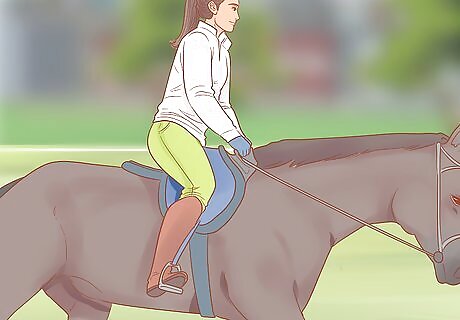
Open your body towards the direction that you want to go. Turn your head, shoulders, and hips toward the right or the left. If you want to move toward the right, apply gentle pressure with your left leg and let your horse move into your right leg. Contrastingly, if you want to move toward the left, apply gentle pressure with your right leg and let your horse move into your left leg. A helpful way to think about turning is that your horse will move off or turn away from the pressure. As your horse begins to turn, follow the motion and let the weight in your seat shift slightly to the outside. Feel your hands, seat, and legs open towards the inside.
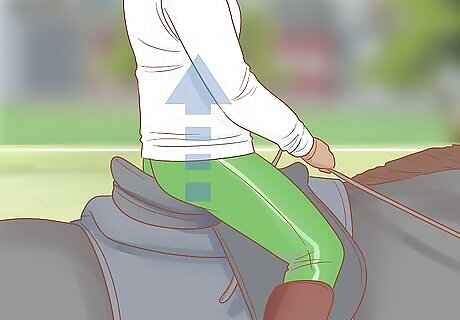
Return to your normal, aligned position to stop turning. Once your horse has turned enough to the right or the left, stop using your turning aids. Position your weight evenly in your seat, look straight ahead, and gently pulse with each leg to ask your horse to walk on again.
Halting Your Horse
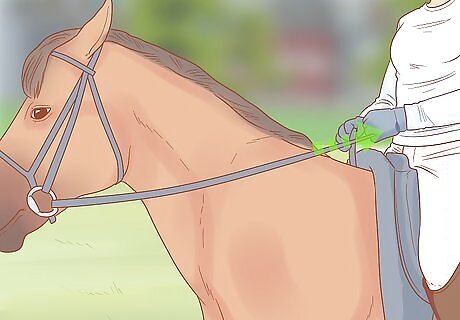
Tense your body when you are ready to stop. Become less flexible and more still to stop following the motion. Slow down the speed at which your hands follow the bobbing motion of your horse’s head. Reduce the flexibility in your hips and seat to stop following the motion. This indicates to your horse that you are going to ask to slow down or stop. Tighten your stomach muscles to reduce the movement in your hips and seat.
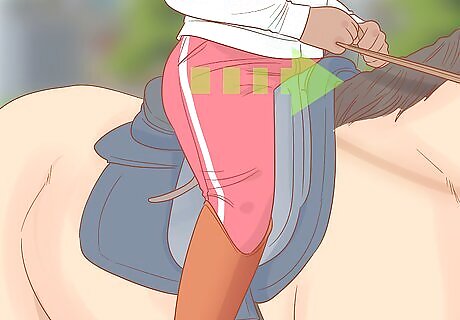
Sink your weight into your seat bones. Relax in the saddle, keep your weight distributed evenly, and make sure that your back is relaxed. Take a deep breath and as you exhale, sink your weight down as you stop following your horse’s movements.
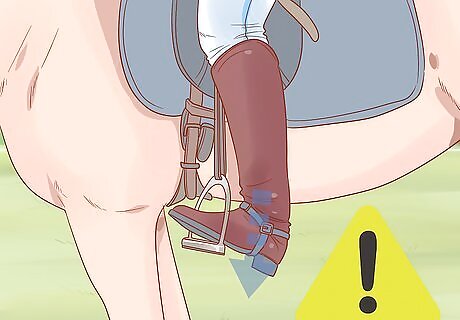
Stop pulsing with your legs. Your legs help to maintain the rhythm and speed of your horse. Stop applying pressure with your legs and let your calves relax and remain still. Your horse will come to a halt.
Changing the Speed
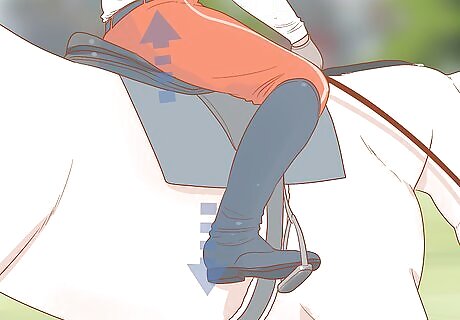
Pulse your legs gently at an increased rhythm to speed up. Keep your body aligned and gently apply more pressure with your lower legs. Lighten your seat slightly by sitting taller.
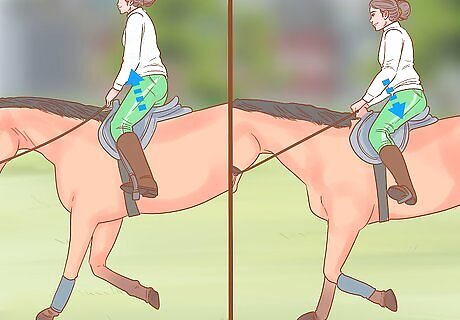
Move your body to follow the same rhythm. Immediately after using your legs, relax your body and become more flexible to your horse's motion to signal an increase in pace. Let your hips and seat be flexible and follow the faster swinging motion. Allow your hands to move with the increased bobbing motion of your horse's head. If you don’t signal your horse using both slight leg pressure and letting your body move forward in the same rhythm, this will be confusing and your horse may not understand what you are asking.
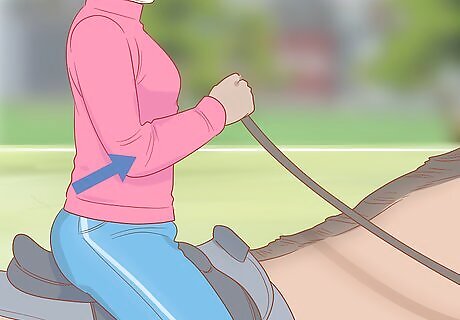
Follow your horse’s motion with your elbows. Once you have started giving the correct signals with your legs, hips, and seat, let your arms relax. Allow your elbows and hands to follow the increased speed. This helps your body to be open to the new movement.

Slow your aids to slow down the pace of your horse. Consistent signals with your seat and legs will communicate to your horse to maintain the same pace. Pulse your legs gently at a slower rhythm and let your hips and seat follow your horse at a slower pace. Once your horse has slowed to your desired speed, use your legs and seat to maintain the movement again. While you are asking your horse to slow down, reduce the slight swinging motion of your hips and gently slow your arm motion. Using your legs and seat in this way helps to reduce the speed of your horse regardless of if it is moving at a walk, trot, or canter.














Comments
0 comment